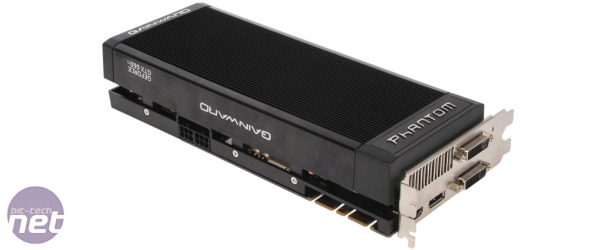Gainward GeForce GTX 660 Ti 2GB Phantom review
December 21, 2012 | 08:51

Performance Analysis
At both 1,920 x 1,080 and 2,560 x 1,600 in Battlefield 3, the GTX 660 Ti 2GB Phantom produces no improvement on the stock card's minimum frame rates of 54fps and 31fps respectively, despite its 10 per cent core overclock. This suggests that memory bandwidth is the limiting factor here, which explains the GTX 670's higher frame rates as well as the slightly improved ones of Zotac's amp! Extreme card, which has a much higher memory overclock. Across three screens, the Gainward card does improve the stock card's minimum frame rate by 2fps, but is still left trailing the AMD Radeon HD 7950 3GB and Zotac's card.In Crysis 2 at 1,920 x 1,080, Gainward's GTX 660 Ti is 3fps faster than the reference card but equally 3fps behind Zotac's, and it also matches the minimum frame rate of the HD 7950 3GB. At the two higher resolutions, there's no boost over the stock card's performance, once again suggesting that memory bandwidth is limiting the card. The HD 7950 3GB trumps the Gainward card by 13 per cent at 2,560 x 1,600, and though it falls behind it across three screens, it's only by 1fps and both cards are unplayable here anyway.
In our 1080p Skyrim test, the Gainward GTX 660 Ti 2GB has a minimum frame rate of 71fps, right between the stock card and the Zotac one. This also gives it a lead on the HD 7970 3GB, but the game does favour Nvidia hardware. At 2,560 x 1,600, the differences between the other two GTX 660 Ti cards increases slightly and the Gainward card also falls behind both the HD 7970 3GB and HD 7950 3GB with Boost. Whereas the Zotac card improves the stock card's minimum frame rate by 4fps across three screens, the Gainward can only do so by 1fps, which leaves it behind even the HD 7870 2GB.
The last game we test with is The Witcher 2, in which the Phantom doesn't improve on the minimum frame rate of the stock GTX 660 Ti 2GB model at 1,920 x 1,080, unlike the Zotac card. Upping the frame rate to 2,560 x 1,600 sees the Phantom add 2fps to the reference card's result (and that of the HD 7950 3GB), but this is still 1fps behind the 34fps achieved by Zotac's amp! Extreme. Finally, in triple screen gaming, there's again no increase in the minimum frame rate of the stock card, which also leaves the HD 7950 3GB ahead by a single fps.
Our Unigine benchmark places the Phantom 5 per cent ahead of a GTX 660 Ti 2GB running at reference frequencies, but also just under 5 per cent behind the Zotac amp! Extreme Edition. Its score of 1,527 is also very close to the 1,513 achieved by the HD 7950 3GB with Boost. Its load and idle power draw figures are right where you'd expect, and under load the HD 7950 3GB draws roughly the same amount of power too. Meanwhile, temperatures are good but not outstanding, and noise levels were generally quiet. The Phantom knocks 3°C off the delta T results of the original GTX 660 Ti 2GB under load, and is 1°C cooler than the Zotac amp! Extreme card, but this latter edition features a heftier overclock.
Overclocking the Phantom provided us with results in the two tests we ran that we unsurprisingly on par with the overclocked Zotac amp! Extreme card, which again suggests that the sort of frequencies we hit are roughly the limit of the GTX 660 Ti 2GB. The Phantom therefore appears to offer few tangible benefits over the Zotac card, despite being much bigger.
Conclusion
We said at the start that for the Gainward GTX 660 Ti 2GB Phantom to stand out it would need to have healthy overclocking potential and a good cooler, but it has neither. Its performance in these areas isn't bad, it's just not better than elsewhere. Overclocking figures are pretty much the same as what we've seen with other card, and the chunky cooler does not reduce noise or temperatures enough to justify its size and consequent lack of versatility compared with other cards. Mini-ITX cases, for example, tend to only have room for dual-slot cards.This leaves the £260 Gainward card in a somewhat sticky situation. For just £30 more, you'll net yourself a GTX 670, which we've always said is the preferable card. Its extra memory controller serves it well now, as it continually outperforms even heavily overclocked GTX 660 Ti 2GB cards, and will continue to be of benefit in future games too. If your budget can't stretch that far, however, there are plenty of cheaper (and smaller) GTX 660 Ti cards to consider (the £250 Zotac amp! Extreme being just one). As the AMD Radeon HD 7950 now costs around £220 for a stock version or £240 for a Boost edition, there's really no good reason to shell out for this overpriced and oversized card.
-
Performance35 / 40
-
Features20 / 30
-
Value14 / 30


MSI MPG Velox 100R Chassis Review
October 14 2021 | 15:04











Want to comment? Please log in.